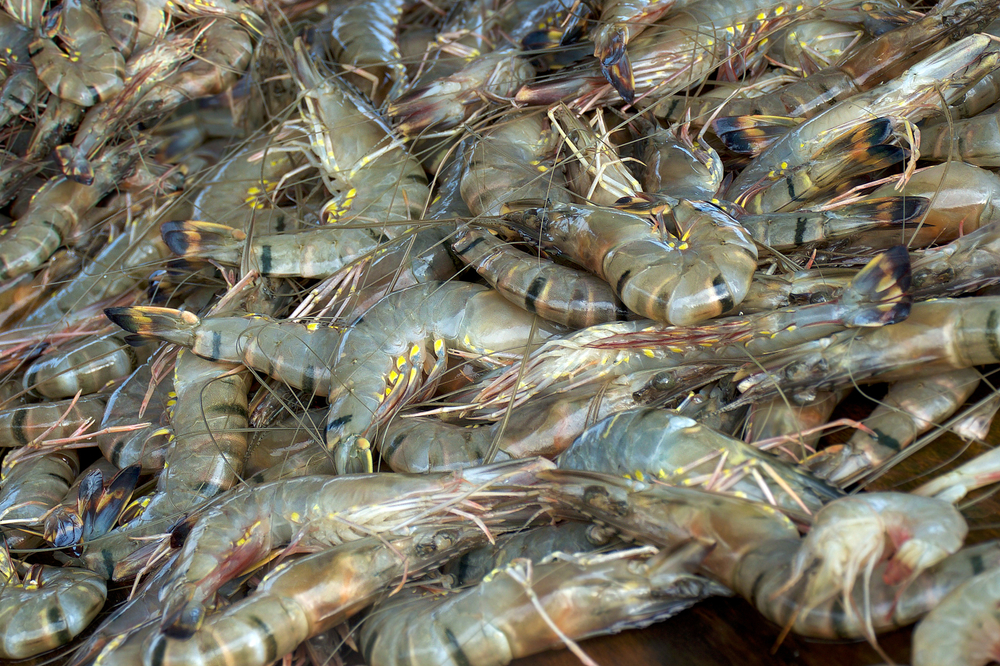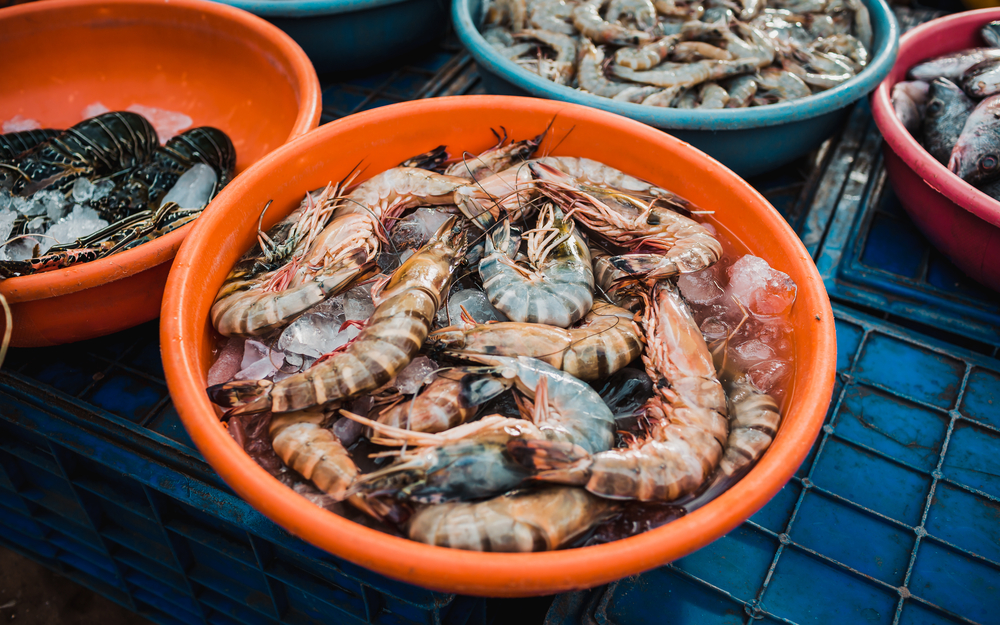When you are looking for the largest shrimp, you need to look beyond your local seafood restaurant.
Recently, a shrimp was found in the Gulf of Mexico that measured eight inches long. Scientists from National Geographic speculate that it could belong to the genus Penaeus.
These shrimp are rare and haven’t been well studied because they live in extreme water depths.
Table of Contents
Fascinating facts about Penaeus shrimp
While you will probably never encounter this shrimp, there are several interesting facts about them.
First, this particular shrimp can discern whether food is alive or dead by its color. They also have tools to protect themselves from predators.
They can create their own bioelectrical fields to detect any predators in the area. And when it comes to other shrimp of their kind, they have the ability to communicate.
The alpha male does this through his antenna muscles, which he can use to create sound waves.
This helps them to locate food and predators.
The biggest shrimp you can buy

The biggest shrimp that you will most likely find is called the extra colossal shrimp. Generally, these will give you a pound with only five shrimp.
Another large variety is the Asian tiger shrimp. With these, you can get a pound with 7–11 shrimp.
Shrimp have always been a favorite food because they have soft and juicy meat. In fact, shrimp fishers in the coastal US states catch 240 million tons each year.
The demand for the product is there as every American eats about four pounds a year.
With over 2,000 varieties of shrimp in the oceans, it makes one wonder which ones you can eat. Some shrimp are not edible.
Some live in places that are so deep that scientists know very little about them.
Types of edible shrimp
There is a variety of edible shrimp that you will find in your seafood market or restaurants. Understanding the differences among them will help you know what you are getting.
Each shrimp type provides its own unique set of qualities and flavors.

- Brown Shrimp
With their brown shell, this shrimp has a firm texture that can sometimes be sweet but can also be slightly salty.
When cooked, they turn pink. These shrimp are best steamed or boiled to preserve their natural flavor.
- White Shrimp
These are large shrimp that can grow to approximately eight inches in length. They have a firm texture and a sweet taste making them a great shrimp for a variety of dishes.
Due to their size, they are great for stuffing, as well as, frying, boiling, and steaming. There are three varieties that you may find in the market including Pacific White Shrimp, Gulf, and Chinese White.
- Rock Shrimp
These shrimp have an extremely hard shell and most fishermen consider them to be a throwaway catch.
In the 1960s, a machine was invented to peel them easily which made them easier to sell.
Their sweet flavor is very close to spiny lobster which makes them an affordable alternative to lobster.

- Tiger Shrimp
This variety of shrimp is found wild and farmed in Asia and Africa. Many markets carry these striped shrimp from India, Thailand, the Philippines, and Vietnam.
They can grow to as large as 12 inches making them perfect for cooking in a variety of ways.
- Pink Shrimp
Most pink shrimp are caught off the coast of Florida. They are better known as salad shrimp because of their small size.
For that reason, they are predominately used in salads and Asian dishes that call for smaller shrimp.
- Spot Shrimp
Sometimes called the “Lobsters of Alaska” due to their similar size and color, they are often used for their unique flavor and sweetness.
They are juicy and soft which makes them difficult to clean as they tend to break apart easily.
However, they can develop up to 12 inches in length.
These are not the only shrimp that can be found in the ocean, but they are the most popular ones that people eat.

Most of these varieties can be found in local supermarkets and fish markets. If you are not sure which variety of shrimp you are looking at, ask because a knowledgeable purveyor will be able to let you know.
Shrimp versus prawns: What’s the difference?
This can be confusing because both terms are often used interchangeably, and the use of the terms varies from country to country.
In basic terms, it comes down to size. Shrimp can be eaten in one bite while prawns are larger.
Perhaps the biggest difference between shrimp and prawns, even though they are in the same family, is that they have markedly different textures.
Shrimp tend to be more succulent while prawns tend to be slightly tougher. Shrimp coming in at 15 or fewer per pound are often called “king prawns” or “jumbo shrimp”.
When shopping for shrimp or prawns, decide beforehand what kind of texture the dish requires.
If prawns are what is needed, be sure to ask the price first as they tend to be more expensive.
This can be a personal choice, however, because the larger prawn will provide each diner with more protein and meat thus filling everyone up quicker.

Freshwater shrimp versus saltwater shrimp
These terms come into play when selecting farm-raised shrimp. Many in the seafood industry began farm raising shrimp as a way of protecting the ocean floors.
The biggest difference is how the shrimp are raised.
Raising a freshwater shrimp requires more equipment and diligence, but it can produce a larger shrimp.
They cannot be raised in tanks as they need more room and ultra-clean water.
Also, they grow slower than saltwater-raised shrimp and can result in cannibalism when raised in smaller ponds.
Saltwater shrimp are often farmed in countries that are near the equator. The extended periods of warm weather allow farmers to produce more than one crop each year.
These shrimp are harvested when the weather gets cooler in the fall.
While it may not matter to many home cooks where their shrimp comes from, it’s good to know there is a difference.
Approximately 25–30% of farmed shrimp come from saltwater farms. The rest are from freshwater farms.

Note: It is particularly important that shrimp with any discoloration not be used for eating. Those that have dark spots or unusual speckling can indicate a product that is no longer fresh.
These signs indicate that the meat has begun to break down.
Understanding shrimp counts
When purchasing shrimp, the label will have numbers. These indicate the approximate number of shrimp that will be in a pound.
This is useful when deciding how many shrimp are needed but it also indicates the actual size of the shrimp.
This chart gives buyers an idea of what to expect when at the supermarket or fish market.
Shrimp per pound and sizes
When you are looking at shrimp in a market, they always come with several numbers. This will help you realize the size of shrimp that you need for the dish that you are making.

Extra Large: 26–30 per pound
Large: 31–35 per pound
Medium-large: 36–40 per pound
Medium 41–50 per pound
These are standard measurements. Again, if there are questions about which size shrimp is best for a particular dish, ask a professional in the market.
They can guide you to the size that is best.
Now for the crazy part
While you may be used to seeing the standard count, there is another label that you may not be familiar with.
The marking “U/15” is also a common standard that means there will be “under” that many shrimp in a pound.
So “U/15” means that there will be under 15 shrimp in a pound.
What is the most widely used shrimp in the world?

The Pacific white shrimp is by far the most popular shrimp in the world. They are found in warm waters and often come from Peru and Baja California.
This popular shrimp accounts for approximately 90% of the shrimp found in markets. It is also the most cultivated.
We all love shrimp, but who discovered we could eat them?
This may seem like a silly question, but it is truly a walk through history. The answer is that a bowl filled with shrimp was found in a cave in South Africa that date back to 165,000 years ago.
This makes it one of the oldest known meals in ancient history.
Seafood is seafood – Does that make shrimp a fish?
The bottom line is no, they are both seafood, but fish and shellfish are very different from one another.
Shrimp are biologically closer to other crustaceans like crab or lobster than they are to fish like tuna.
This shouldn’t ever stop anyone from consuming anything in the seafood category – it’s just a curious question.
Bigger is better, right?

That is not always true. Large shrimp, jumbos, or colossus sizes all have their place, but they are less tender than their smaller cousins.
Some restaurants provide them because customers tend to believe that bigger is better.
They definitely provide the briny flavor and texture profile that some recipes call for, they just aren’t as tender as smaller shrimp.
Head-on, or head-off?
Most shrimp purveyors sell head-on shrimp to the European markets as many Americans find head-on shrimp to be unappetizing.
This viewpoint is changing, as several high-profile chefs in major US cities such as New York City and San Francisco began offering dishes with head-on shrimp.
As diners experience these dishes, they are beginning to embrace head-on shrimp as a global culinary trend.
Buying head-on shrimp
If you decide the purchase shrimp with their head on, there are several things to understand.
For jumbo shrimp, there will be about 21–25 to a pound. With colossals, buyers can expect about twelve to the pound.

The size needed will depend on how the shrimp are prepared.
Purchasing shrimp
There are many places where you can purchase shrimp. Supermarkets, fish markets, and even some farmer’s markets offer many popular varieties.
The absolute best place to purchase shrimp, however, is to catch the shrimpers at the dock when they come in.
Buyers can get the best price for the freshest product. While this is not an option for everyone, if it is possible, take advantage of it.
Understanding shrimp is not a difficult proposition. With a little information, selecting the right shrimp for a dish is easy.
Shrimp are easy to store in the freezer and have on hand when you are ready to cook them.
For someone unfamiliar with which type of shrimp to choose the best place to start is with Pacific white shrimp.
They can be prepared in a wide variety of dishes from gumbo to pasta to sauces. They are extremely versatile and readily available.

Cook them up and dive in. When ready, select some of those largest size shrimp for an extraordinary experience.
Every type of shrimp has its own unique qualities, so explore them all.

















